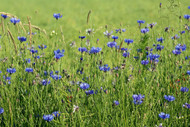How to establish a wildflower meadow
If you are looking to establish a wildflower meadow there are a few factors to consider including the type of soil in your site area, and which wildflowers you will be sowing.
Preparation
When sowing wildflower seed, the first thing you need to consider is ensuring that your seed bed has been treated and is clean to allow for the most effective results. You can start by removing any existing vegetation, followed by a light rotovation. We recommend that you do not rotovate any deeper than 2-3 inches, as anything deeper may result in you churning up dormant “weed” seeds that will then take over the seed bed.
Starting with a clean seed bed is key, so if there are existing seeds in your chosen area it is important to allow them to germinate and begin to grow before being removed by your chosen method. This process may need to be carried out up to three times to ensure ideal preparation of your final seed bed which will then be ready for sowing after a light raking.
Sowing into bare soil
If you are sowing into bare soil we recommend a 100% wildflower mix at a rate of 1-2g/m2, and as previously mentioned it is important to ensure that your site is weed-free and correctly prepared for wildflower sowing. If you are sowing a perennial species bare in mind that you may not see colourful flowering until the second year of establishment.
Sowing into existing grassed areas
It is more difficult to establish a wildflower meadow in existing grassed areas, but not impossible. For the best results we recommend sowing either a 100% wildflower mix or an 80% grass/20% wildflower mix and ensuring that you lightly press the sown area down with a roller or other methods after planting to guarantee that there is good contact between the seeds and the moisture in the soil. Regularly watering the site after planting is also crucial for seed establishment, especially if it is Spring sowing and is at a drier period of the year.
Maintenance in the first year
First year maintenance is important in general, but even more so if grasses are present either as existing vegetation, or if they have been sown in as part of an 80/20 mix. If care is not taken to control grasses, your wildflowers may struggle to establish.
We recommend doing regular cuts every 4 weeks or so down to a height of around 60-70mm. This is the most important step of first year maintenance as grasses are more dominant and harder to control, so they will inhibit the growth of your wildflowers in order to boost their own growth. With this regular cutting of the whole sward, your wildflowers will be given the chance for stronger root development, and whilst they may not be ready to bloom yet, they will be in a much stronger position for year 2 and will be ready to flourish then.
Maintenance in the second year
The first cut of the second year can be carried out in early Spring, just before the growing season starts. This cut is normally required just to clean up growth from the Winter that has just passed. Be sure to remove the cuttings as usual and create “Habitat Piles” if you can’t clear the clippings from the site completely. After this another cut won’t be needed until the flowering season has ended around late summer, once the wildflowers have developed seed heads and bloomed. You will then not need to do another cut until the following Spring. As time goes by more wildflower species will establish and bolster your meadow, and the sward will find a natural balance between grasses and wildflowers.
If all these steps are followed carefully and correctly, you should have no issue with establishing a wildflower meadow no matter the conditions of your site or the species you are choosing to plant.
If you require any further assistance or have any queries regarding establishing a wildflower meadow, be sure to contact our team on email at sales@gardenersupplies.co.uk and we will be happy to help.

